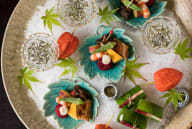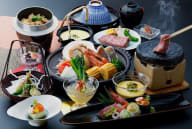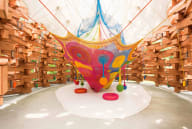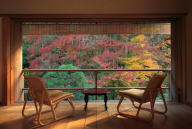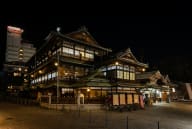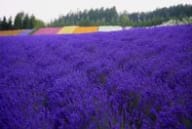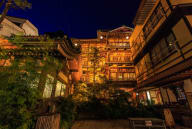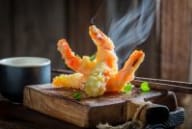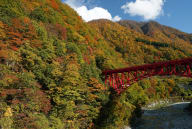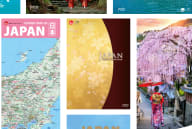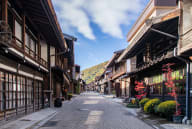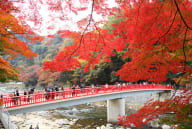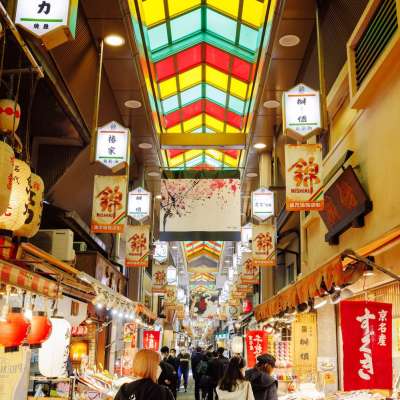
Kyoto Ancient flavours, simply elegant, truly authentic cuisine
A Culinary Journey in Kyoto
Kyoto is a city steeped in history and culture, with a rich culinary tradition that reflects its imperial past and vibrant present. As the former capital of Japan for over a thousand years, Kyoto offers a culinary journey that blends ancient traditions with modern innovations.
Kyoto is celebrated for its exceptional agricultural produce, forestry products, and seasonal delicacies. The fertile lands of the prefecture yield a variety of high-quality vegetables, such as Kyoto's renowned Kyo-yasai, including Kyoto carrots and Shogoin daikon radish. The prefecture is also known for its Yuba (tofu skin) and Uji tea, one of Japan's most famous varieties of green tea. Kyoto's culinary scene features an array of traditional dishes, such as Kyo-kaiseki, a multi-course meal that highlights the seasonal ingredients and meticulous preparation techniques, and Yudofu, a simple yet elegant tofu hot pot that exemplifies the prefecture's focus on purity and subtlety in flavours.
Kyoto's numerous tea houses, known for their ceremonial tea services, and Nishiki Market, often referred to as "Kyoto's Kitchen," offer visitors an immersive experience of the local food culture. Whether wandering through the serene Arashiyama Bamboo Grove or enjoying a meal in a historic Machiya townhouse, Kyoto invites you to savour its cuisine as well as its scenery, offering culinary elegance defined by tradition, artistry, and seasonal bounty.
Sample in the elegant flavours and rich culinary traditions characteristic of the old capital.
Yatsuhashi (Cinnamon-seasoned rice flour confectionery)

What it is (ingredients)
Yatsuhashi is a traditional Japanese sweet from Kyoto, made primarily from glutinous rice flour, sugar, and cinnamon. The dough is thinly rolled out, cut into triangular shapes, and then baked or steamed. They can be enjoyed in their original form, which is soft and chewy, or as a crispy version that has been baked to perfection.
History/Origin
Yatsuhashi is believed to date back to the Edo period (1603 - 1868), when it developed alongside Kyoto's tea culture. In the Meiji period (1868-1912), with the opening of railroads, Yatsuhashi gained popularity among the newly emerging tourist industry due to its distinctive texture, aromatic cinnamon flavour, and extended shelf life. Today, it is still a quintessential Kyoto souvenir, often beautifully packaged and gifted to friends and family.
Where to Eat
Yatsuhashi can be found in numerous traditional sweet shops (Wagashiya) across Kyoto, or souvenir shops, particularly in districts like Gion and Higashiyama. In addition to the standard cinnamon and matcha flavours, Yatsuhashi is available in a variety of flavours including strawberry, chocolate, cherry, plum, chestnut, and more.
When to Eat
Yatsuhashi is enjoyed throughout the year as a snack with tea or as a dessert after meals. It is also commonly given as a souvenir to commemorate visits to Kyoto, making it a cherished treat for special occasions and everyday indulgences alike.
Experience the delicate flavours of Kyoto with Yatsuhashi, a beloved sweet that embodies the cultural richness and culinary artistry of Japan's ancient capital.
Kyoto style pickles
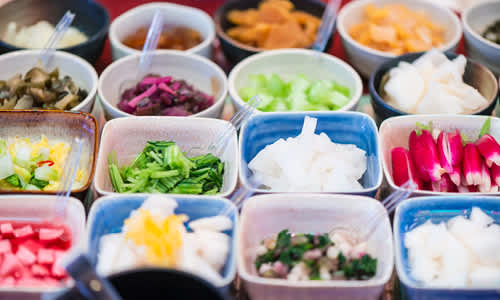
What it is (ingredients)
Kyoto-style pickles, known locally as "Kyo-tsukemono," encompass a variety of preserved vegetables. These pickles are typically made from locally sourced vegetables such as cucumbers, eggplants, radishes, and ginger. They are brined or fermented with salt, rice bran, or vinegar, resulting in a range of flavours from tangy to subtly sweet or spicy.
History/Origin
The history of pickles in Japan spans centuries, with Kyoto's basin area being particularly suitable for growing vegetables, leading to the development of a rich pickle culture. Kyoto pickles are especially known for their juiciness and deliciousness. Among them, "Shiba-zuke" is made by salting summer vegetables like eggplant with chopped red perilla leaves, "Senmaizuke" is created by thinly slicing Shogoin turnip and pickling it with kelp, and "Suguki-zuke" is fermented with lactic acid bacteria using traditional methods, these are collectively known as "Kyoto's three major pickles." Initially developed as a method of preserving vegetables, Kyoto pickles have evolved into an art form characterized by meticulous preparation and attention to detail.
Where to Eat
Kyoto style pickles are integral to Kyoto's culinary scene and can be found in traditional pickle shops, markets, and specialty stores throughout the city. Many restaurants and Ryokan (Japanese inns) also serve Kyoto tsukemono as part of their kaiseki or as a side dish accompanying meals.
When to Eat
Kyoto style pickles are enjoyed year-round, and are often served as appetizers or accompaniments to rice dishes. They are particularly refreshing during Kyoto's hot summers, offering a crisp and flavourful contrast to other dishes.
Discover the artistry and flavour of Kyoto style pickles, a quintessential part of Kyoto's culinary heritage.
Tofu cuisine
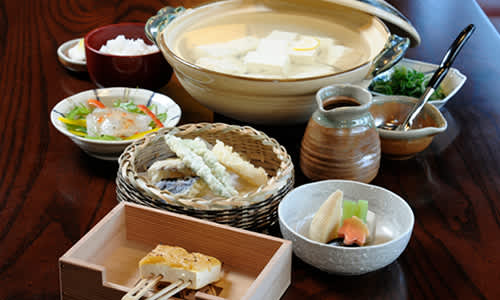
What it is (ingredients)
Kyoto's tofu cuisine showcases the simplicity and elegance of this versatile ingredient. Tofu is made from soybeans, water, and a coagulant, often Nigari (magnesium chloride) or calcium sulphate. In Kyoto, tofu is celebrated in various forms, such as Yudofu (simmered tofu), Koya-dofu (freeze-dried tofu), and yuba (tofu skin), each prepared to highlight its delicate flavours and smooth textures.
History/Origin
Tofu has been a dietary staple in Japan for over a thousand years, while Kyoto’s abundant sources of pure water and proximity to high-quality soybeans made it an ideal location for crafting superior tofu. Buddhist monks, adhering to vegetarian diets, further refined tofu-making techniques, contributing to its esteemed place in Kyoto's culinary heritage.
Where to Eat
Kyoto is home to numerous tofu specialty restaurants, particularly in areas like Arashiyama and Gion. Traditional establishments offer a variety of tofu dishes, allowing diners to experience the subtle nuances of Kyoto style tofu. Additionally, local Ryokan (Japanese inns) often feature exquisite tofu cuisine as part of their kaiseki meals.
When to Eat
Tofu cuisine can be enjoyed throughout the year, with each season bringing its own unique tofu dishes. In winter, warm Yudofu (boiled tofu) is a comforting favourite, while in summer, chilled Hiyayakko (cold tofu) provides a refreshing treat.
Experience the refined flavours of Kyoto's tofu cuisine, where centuries-old techniques and pristine ingredients come together to create a truly exceptional dining experience.





















